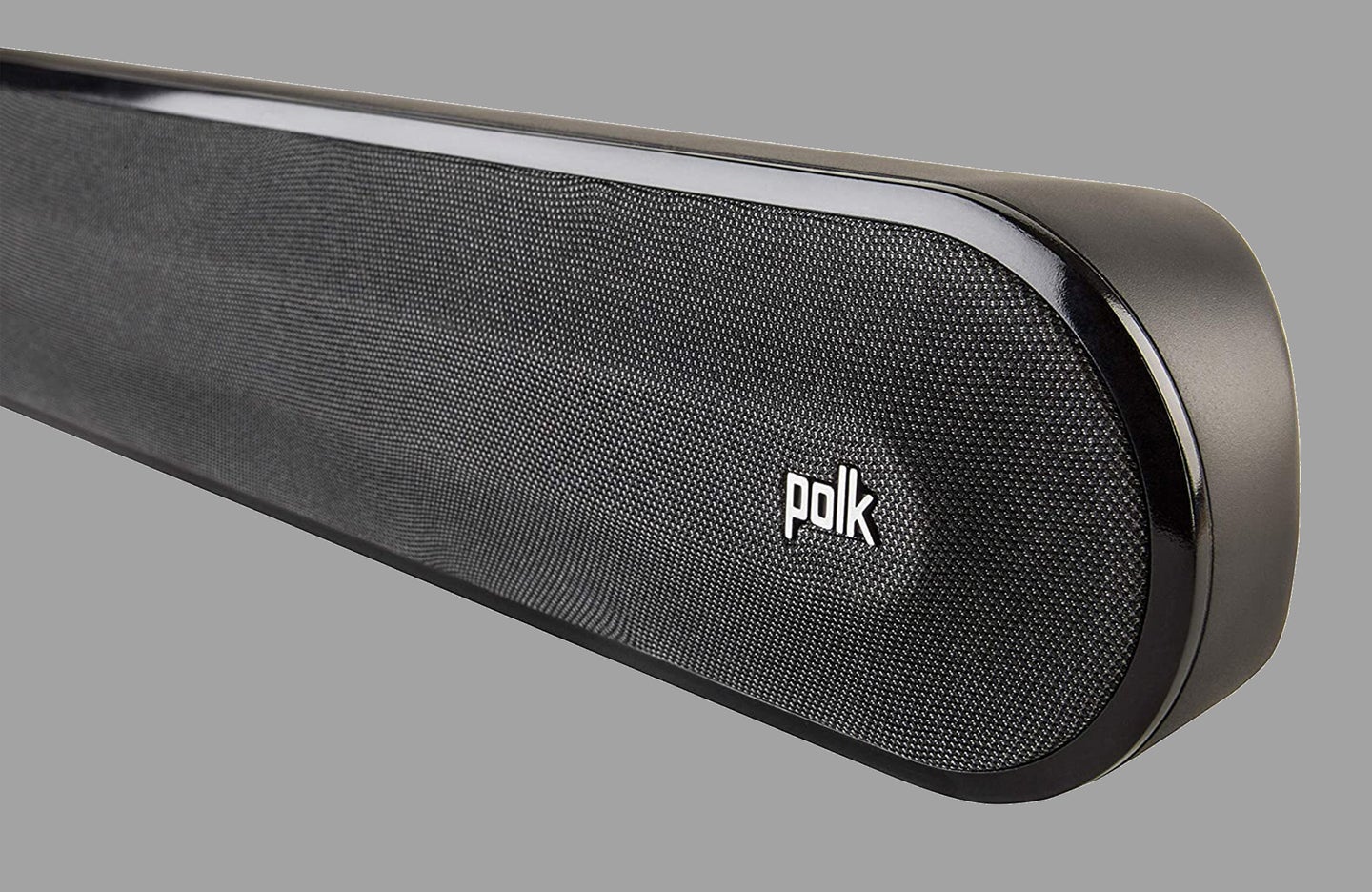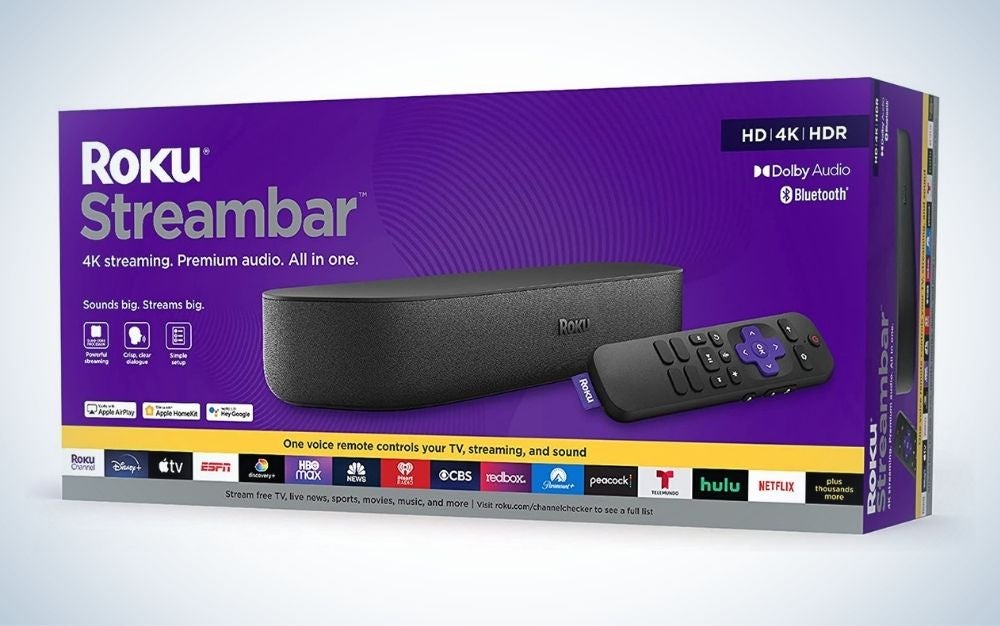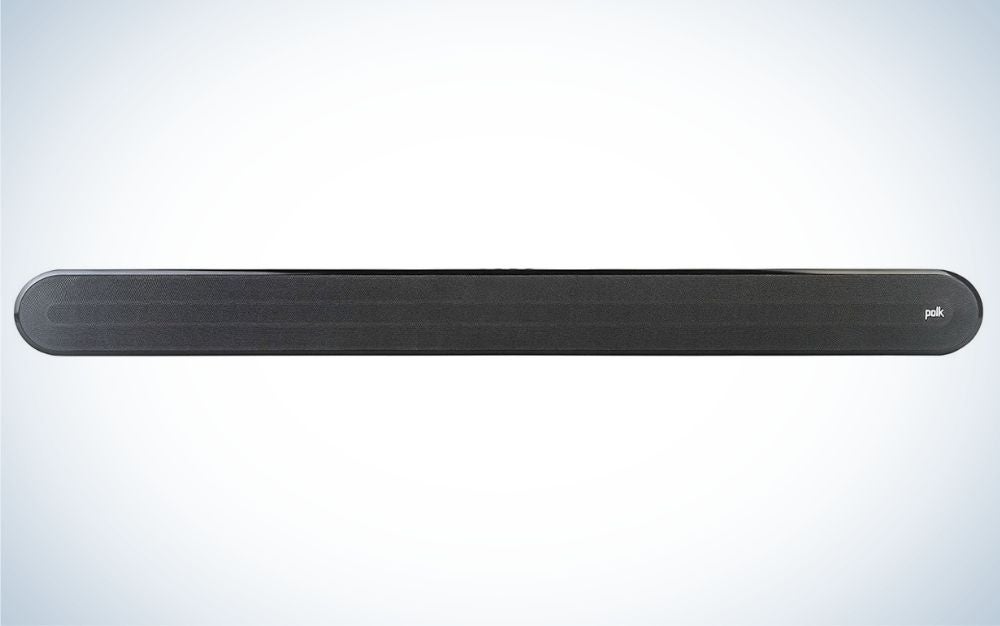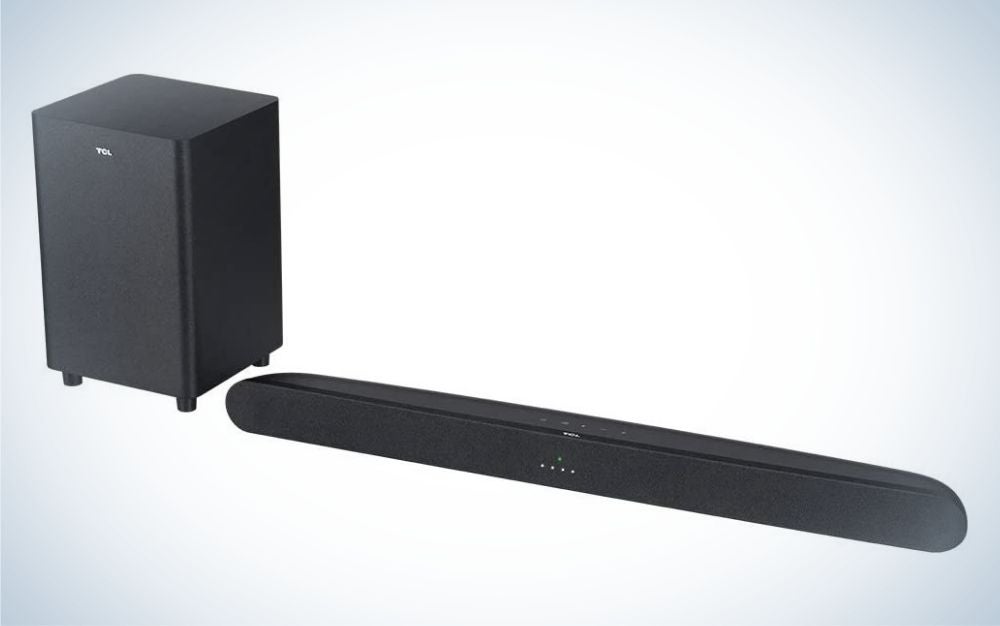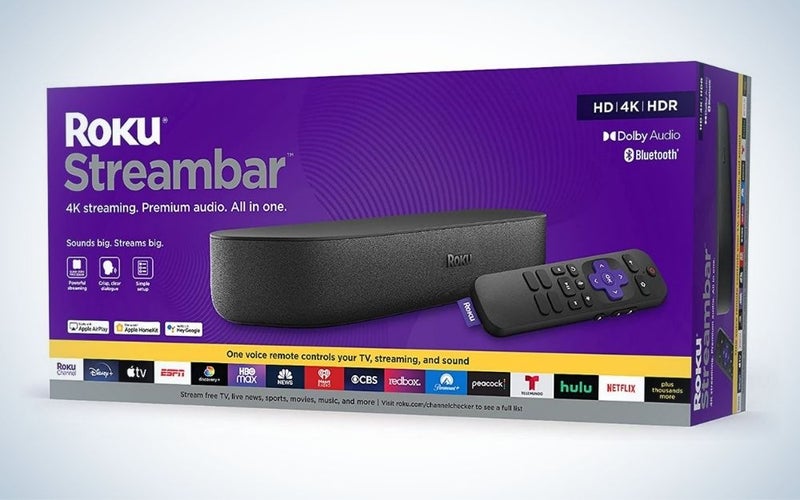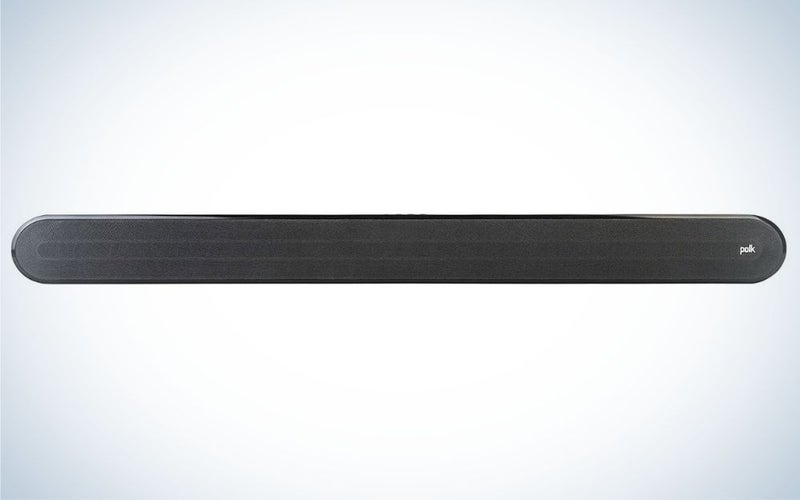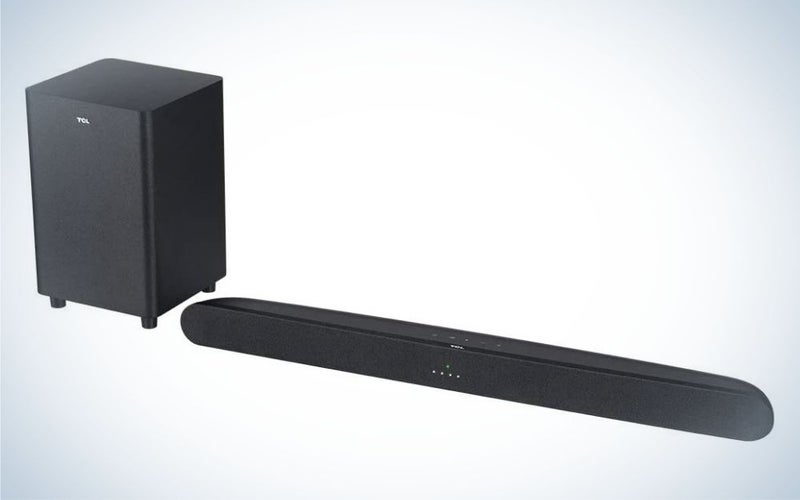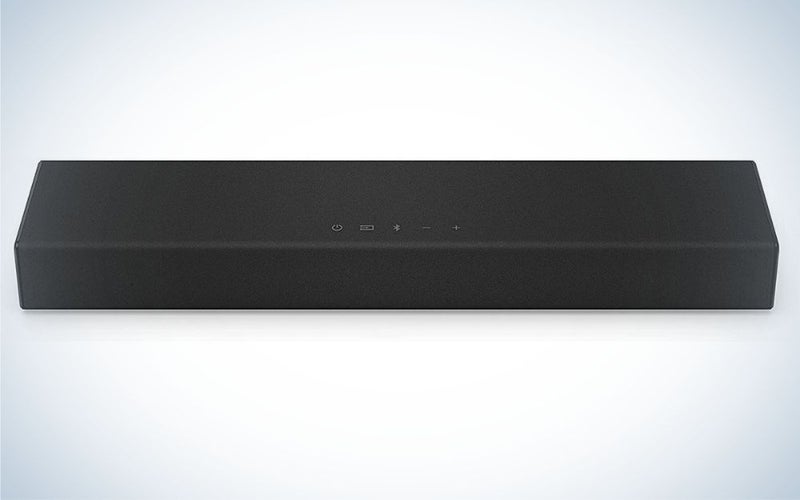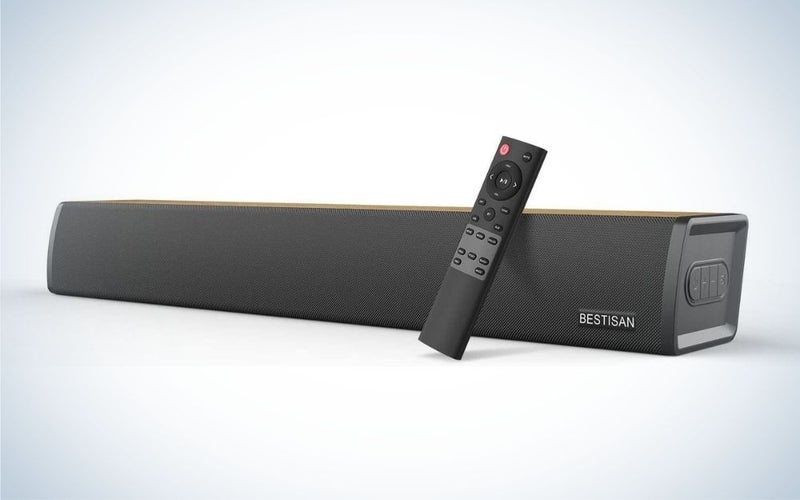We may earn revenue from the products available on this page and participate in affiliate programs. Learn more ›
If you’ve heard the hubbub about improving your television’s audio but you’re not ready to shell out the big bucks, fear not—budget soundbars to the rescue. A cheap soundbar might not let you experience theater-quality Dolby surround sound, but you will undoubtedly hear crisper dialogue, more detailed music, and a balanced relationship between script and score with the help of these specifically designed speakers. A compact, wallet-friendly soundbar is a great way to start experimenting with at-home audio; they are easy to install, easy to use, and easy to expand should you want to continue upgrading. And if you’re new to soundbar shopping, we’re here to help you pick one of the best soundbars under $100 suited to your needs and your living space.
- Best overall: Roku Streambar
- Best TV soundbar: Polk Audio Signa Solo
- Best soundbar and subwoofer: TCL Alto 6+ TS6110
- Best small soundbar: Vizio SB2020n-J6
- Best budget: Bestisan 60W Bluetooth Soundbar
How we selected the best soundbars under $100
In order to select the best soundbars under $100, we paid particular attention to audio specs, including Dolby Digital support and number of audio channels. We also took a look at connectivity, expandability, and overall design to ensure each model is equipped for most televisions. Finally, we explored available simple yet special features, prioritizing the most useful like Bluetooth and Wi-Fi compatibility, navigable remotes, etc. We looked at reputable brands whose more expensive models perform consistently well, like Vizio, consulted critical peers and first-hand user impressions, and looked inside our own homes to bring you the best budget-friendly soundbars.
Things to consider before buying one of the best soundbars under $100
What to expect
An affordable soundbar is a great way to get a little more when it comes to film and television audio at home. Since the late ’90s/early 2000s, flatscreen TVs have been taking over the town and, while the overall viewing experience has vastly improved, the slim design of newer televisions means less room for suitably sized built-in speakers. Soundbars were created to circumvent this problem, providing a sleek, compact speaker system that won’t detract from a flatscreen’s streamlined aesthetic.
While you don’t need to shell out thousands of dollars for a soundbar, a few hundred dollars can go a long way regarding improved fidelity, more expansive coverage, and multichannel options. However, if you want to stick with your budget want a soundbar now, focus on finding one of the best soundbars under $100 from a reputable brand, so you don’t spend more on replacements or repairs down the line.
Connectivity
Soundbars are designed to bypass your TV’s built-in speakers, offering more expansive coverage and better audio. To set up and reap the rewards of a supportive soundbar, you’ll need to understand the connectivity ports on both the model you’re looking at and your television. Most soundbars use an HDMI port (and HDMI cables) to connect; however, if your TV was made over a decade ago, you might need to grab a soundbar with an optical audio port instead—luckily, most soundbars provide both.
Beyond standard HDMI and optical audio ports, connectivity options will vary. Some are equipped with additional HDMI output ports, allowing you to connect gaming consoles and Blu-ray players, passing the signal through to the TV. Some will offer wireless connections via Bluetooth or Wi-Fi so you can connect additional smart devices to stream music, podcasts, or audiobooks.
Most units available for under $100 won’t be able to support more advanced connections like HDMI eARC, which is recommended for Dolby Atmos soundbars and necessary for processing Atmos audio encoded with uncompressed Dolby TrueHD audio. So, if you’re looking to try out immersive Dolby Atmos surround sound, you’ll need to spend more. A few will let you connect a voice assistant, like Alexa or Google Assistant, so that you can implement voice control.
Dolby Digital and beyond
Many soundbars say they support Dolby sound, but that doesn’t mean they are talking about the Dolby Atmos surround sound or other advances in spatial audio; for that, you’ll need a more robust model with either physically upfiring drivers or the processing power to virtualize such a configuration. However, a more reliable, affordable soundbar will support Dolby Digital—an audio codec that produces high-quality sound across a 5.1-channel scheme. And you don’t need a 5.1 system to deal with Dolby Digital; a 2.1-channel system can process the audio by mixing down the signal and formatting it to fit the soundbar’s channel configuration.
DTS:X, a multidimensional audio codec, can be considered Dolby Atmos’ competitor. Most soundbars under $200 do not support DTS:X but might employ DTS Virtual:X, which attempts to mimic multispeaker surround sound using digital signal processing, simulating directionality and creating a larger, more detailed soundstage impacting music, dialogue, and SFX alike.
Expandable systems/audio channels
A single soundbar does not mean a single speaker, as even the simplest of soundbars employ multiple drivers to produce audio. Standard models offer stereo sound, meaning an independent left and right channel, also called a 2.0-channel system. Some utilize 2.1 channels; the .1 describes an external subwoofer to support lower bass frequencies. These subs will either be built into the main soundbar or as a separate unit. This is typically where an inexpensive model will cap its channels, but other systems can incorporate up to 7.2 channels. A 3.1 system will incorporate a left, right, and center channel alongside the additional sub. And 5.1 systems will utilize one main soundbar, containing the left, right, and center channels, one subwoofer, and two additional speakers that act as surrounds, rears, or front fills for an even more immersive experience.
If a more expansive system sounds appealing, but you’re not ready to commit just yet, choose a soundbar that you can add to. Some are designed as standalone units, not compatible with additional speakers; however, others (such as the Roku system) can support satellite speakers and a subwoofer created by the same company. No matter how big or small you want your system, or your investment, we have options in our picks for the best soundbars under $100.
The best soundbars under $100: Reviews & Recommendations
Best overall: Roku Streambar
Roku
Why it made the cut: The Roku Streambar is a great way to start your soundbar system, with a built-in streamer and the option to add a subwoofer or satellite speakers down the line.
Specs
- Dimensions: 14 x 2.4 x 4.2 inches
- Channels: 2.0
- Connectivity: HDMI ARC, Bluetooth, Optical, Wi-Fi, AirPlay
Pros
- AirPlay and Wi-Fi compatible
- Integrated Roku player
- Expandable
Cons
- Bass is lacking
- Volume is a bit limited
Reminiscent of a burrito-sized Bluetooth party speaker, the Roku Streambar is ideal for watching television shows or streaming other dialogue-based programs, like podcasts or audiobooks. While it lacks the booming bass a 2.1-channel system provides, this soundbar can get quite loud despite its small stature, delivering a tested frequency response of 93Hz-17kHz from four 1.9-inch full-range drivers. And if you find you have the space and budget to expand, you can upgrade the Streambar by seamlessly integrating Roku’s Wireless Subwoofer and/or Wireless Speakers to make a true 3.1 or even 5.1 system with just a few minutes of automated setup.
Connectivity options include HDMI ARC, optical, USB, Bluetooth 4.2, Wi-Fi, and Apple AirPlay. And if you don’t have a smart TV or another streaming device, you get the added bonus of the Streambar’s built-in Roku streaming services and apps including Hulu, Netflix, Spotify, Youtube, Amazon Prime, and more (making it one of our favorite streaming devices).
EQ presets include Normal, Bass Reduction, Bass Off, and Bass Boost. You can also access Volume Mode settings, including Leveling and Night Mode, to wrangle raucous commercials and keep things quiet in the evenings. Speech Clarity can help isolate voices, and you can choose from Off, Low, and High settings depending on your needs and taste.
Best TV soundbar: Polk Audio Signa Solo
Polk Audio
Why it made the cut: The Signa Solo is a straightforward soundbar that prioritizes audio quality and provides a few EQ presets along the way.
Specs
- Dimensions: 3.91 x 39 x 3.59 inches
- Channels: 2.0
- Connectivity: Bluetooth, Optical, Aux
Pros
- Wall-mountable
- Music Mode
- SDA digital surround sound
Cons
- No HDMI port
The Signa Solo is the most affordable model offered by soundbar/speaker company Polk Audio. It features four 2.5-inch full-range drivers with bass ports to boost the low end—packed within a low-profile enclosure perfect for sitting underneath, and enhancing what’s on, the TV. While this soundbar doesn’t have an HDMI port so it can’t accurately produce Dolby Atmos audio, it connects easily via optical and is equipped with Polk’s very own SDA digital surround technology, which helps establish a more immersive soundstage.
The included remote allows you to adjust volume, control the bass, select VoiceAdjust settings, and lift dialogue above the music and background noise for enhanced clarity. You can also choose between Movie and Music EQ modes, making this Signa Solo an excellent option for those looking for a soundbar that doubles as a Bluetooth speaker. If you’re interested in the Signa Solo but don’t want to take any chances when it comes to bass support, Polk also offers an affordable 2.1-channel system.
Best soundbar and subwoofer: TCL Alto 6+ TS6110
TCL
Why it made the cut: The TCL Alto 6+ is one of the only models that retail for around $100 and includes a standalone subwoofer.
Specs
- Dimensions: 31.5 x 2.4 x 4.2 inches
- Channels: 2.1
- Connectivity: HDMI, Optical, Bluetooth, USB, Aux
Pros
- Included Subwoofer
- Bluetooth Connectivity
- Roku TV-ready
Cons
- EQ options are limited
- Cannot adjust bass
The Alto 6+ is an affordable 2.1-channel soundbar and subwoofer that’s easy to install and control. It features multiple connectivity options, including Bluetooth for wireless streaming and Aux inputs for connections to older devices. EQ presets include Movie, Music, and TV mode for enhancing dialogue. The 6+ can also decode Dolby Digital audio, downmixing 5.1 surround sound to 2.1 stereo sound.
The included subwoofer does have a power cable but connects to the main bar wirelessly, so you don’t need to worry about TV proximity to get room-filling sound (though there are still things to consider when it comes to optimal subwoofer placement). And if you have a Roku TV, you’re in luck because the Alto 6+ is “Roku Ready,” meaning it’s optimized for the pairing and compatible with your TCL Roku remote.
Best small soundbar: Vizio SB2020n-J6
VIZIO
Why it made the cut: This soundbar from Vizio is a super-compact way to improve your TV’s audio.
Specs
- Dimensions: 2.2 x 20 x 4.4 inches
- Channels: 2.0
- Connectivity: Bluetooth, Optical, Aux, USB
Pros
- DTS Virtual:X support
- Voice Assistant compatibility
- Price
Cons
- Can distort at loud volumes
- Does not support Dolby Digital
Vizio is one of our highly recommended brands when it comes to affordable soundbars and its most inexpensive option, the S6, is no different. Simple and straightforward, this model offers Bluetooth connectivity, Night Mode for balanced audio during quiet time, and Bass/Treble adjustment. It also has four EQ presets, including Movie, Music, Dialogue, and Game modes. Though it does not support Dolby Digital audio, it can utilize DTS Virtual:X, adding virtual height and surround elements to encoded content.
At just 20-inches long, this sleek soundbar will fit neatly under most televisions and is easy to connect or adjust. Yet it manages to pump 91 dB—impressive for such a small footprint. This streamlined unit is a great option for guest rooms, secondary TV sets, or first-time soundbar users. And, easily portable, it can be moved to wherever the party’s at.
Best budget: Bestisan 60W Bluetooth Soundbar
BYL
Why it made the cut: The Bestisan soundbar is the only model on this list that retails for under $65, a budget-friendly steal that will still sound better than your TV’s built-in speakers.
Specs
- Dimensions: 3.2 x 24 x 3.7 inches
- Channels: 2.0
- Connectivity: Bluetooth, Optical, Aux, USB, Coaxial
Pros
- Enhanced Bass
- Treble adjustments
- Price
Cons
- Sound quality is a bit lacking
The Bestisan soundbar provides reliable sound for a fraction of the cost of other affordable models. While it’s not going to blow the roof off your house when it comes to volume or provide luxury audio quality, it will likely sound better than your TV speakers, and that’s a worthy upgrade. This 60-watt soundbar supports sound with two 3-inch full-range speakers with bass reflex tubes to help bolster the bass. It comes with three DSP (digital signal processing) presets: Dialogue, Movie, and Music; plus, you can make additional EQ adjustments to the bass and treble via buttons on the included remote control.
There isn’t an HDMI port but you can connect to devices with Bluetooth 5.0 or simply use the digital optical audio port. Onboard controls include play, pause, volume control, and power; you can also look to the main unit, which displays a different LED light color to correspond with the current input selection. The unit also comes with a wall mounting kit, so you can listen in style without taking up extra space.
FAQs
Q: Can you use a soundbar without a TV?
Yes, technically, you can use a soundbar without a TV, depending on the connectivity options. Models equipped with Bluetooth or Wi-Fi can connect to smartphones, laptops, etc., to stream music and podcasts wirelessly. You can also use AUX or USB ports to connect additional devices directly. However, soundbars are first and foremost designed with the intention of supporting film and television audio. So if you find yourself wanting to play music primarily, consider turning your attention to budget-friendly bookshelf or Bluetooth speakers instead.
Q: What does a subwoofer do with a soundbar?
Adding a subwoofer to a soundbar system supports low-end frequencies that the main unit may not be able to bolster. A sub helps produce that heart-pounding bass and anxiety-inducing rumble found in sound design and scores alike. Some can live without it, but we recommend the upgrade; they can be a real game-changer when it comes to an entertaining viewing experience.
Q: Are cheap soundbars worth it?
Yes, a cheap soundbar is a great way to start making small improvements to your home audio system before committing to something more expensive. While they may not be able to keep up with popular advancements in audio, like spatialization and three-dimensional, nor will they be able to satisfy selective audiophiles, they are a great way to introduce yourself to the possibilities of at-home system reinforcement.
Final thoughts on finding the best soundbars under $100
Better sound doesn’t have to cost a fortune. As long as you set yourself up for realistic expectations and focus on function over luxury features, you’ll be able to find the best soundbars under $100. Before you buy, think about connectivity and compatibility to ensure your soundbar can support your television. From there, you can consider how many audio channels you need and if you’ll want to expand in the future. But, for now, start with a simple soundbar that will enhance your TV-watching game.
